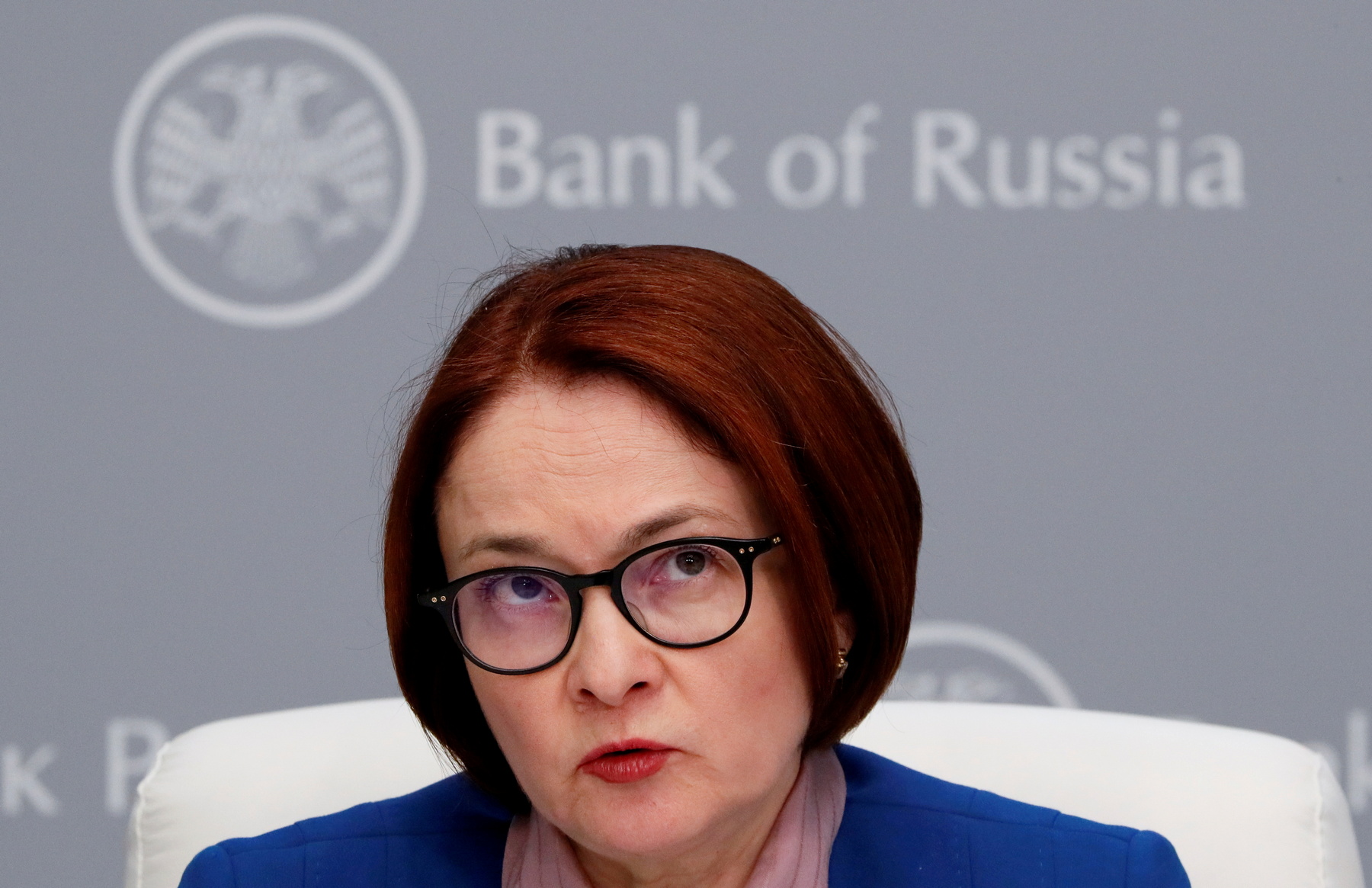Addressing the Duma on the state of the economy and the Central Bank’s policy outlook, Bank of Russia governor Elvira Nabiullina laid out a straightforward analogy for what’s ailing the Russian economy, and by extension the basis for Moscow’s criticisms of policy choices in the United States and Europe.
The economy, Nabiullina described, is a living, breathing organism not designed to sprint for long periods of time. If you attempt to “pump up” the economy above its potential for too long, “inflation goes off the scale like a runner’s heartbeat, followed by a loss of growth rates – shortness of breath – and then a heart attack – an economic crisis.”
That is why Nabiullina has signalled more interest rate rises to combat the scourge of inflation, the primary culprit making Russians poorer as prices continue to increase. The Bank of Russia intends to slow down the rate of consumption, spending, and investment across the economy by making it more expensive to borrow. Yet Nabiullina’s analogy and strategy does not speak to another coming challenge obscured by today’s inflation figures: deflation.
Unlearning Orthodoxy
In fairness, Russian policymakers are understandably panicked about the risks of rising prices. Institutional and personal memories of the late Soviet economy and Yeltsin years run deep. The Bank of Russia’s focus appears to be “anchoring” inflation expectations by convincing the public and markets that it’s happy to inflict pain, reduce consumption, and weaken growth on the assumption that expectations of price increases will create a self-fulfilling inflationary cycle. Social surveys carried out by the Levada Centre show that over the last three decades, Russians are almost always most concerned about rising prices. There’s just one problem: there’s little empirical evidence that expectations drive inflation.
A paper authored by Jeremy Rudd, a senior advisor on the US Federal Reserve’s Board of Governors, made a splash in the United States in recent months by demolishing assumptions that expectations of price increases have much to do with actual price increases. To simplify, expected inflation affects household sentiments about their finances and their plans to spend but does not explain actual increases in price. Most of price hikes globally come from imbalances in supply and demand for goods and commodities, or from bottlenecks delivering key inputs or finished goods. For instance, a factory can’t keep pace with semiconductor orders. Or, not enough natural gas in storage for winter and prices spike.
These are global problems but are evident in the Russian economy. MinPromTorg is currently scrambling to address skyrocketing transport prices for metallurgical and construction materials. Auto transport costs are up 10-25% and rail transport costs are up anywhere from 20-90%. Russian port operators are complaining that a lack of capacity from Russian Railways is killing the business case to expand port terminal capacity. Wholesale prices for potatoes and cabbage are up a whopping 70% because of supply pressures and costs of production inputs — not from surging food demands. Employers often cite labor shortages as an issue. None of these factors are addressed by raising interest rates. In fact, all would gain from lower rates.
The Bank of Russia partially admits this. The head of the monetary policy department Kirill Tremasov explicitly acknowledges food prices will remain higher through 2022 due to poorer harvests. Inflation has leveled off in November insofar as the rate of price hikes finally achieved some semblance of stability. Yet now, banks are forecasting further rate hikes to the 9.5-10% range. When supply constraints of various kinds are the cause of inflationary pressures, there are few compelling arguments to raise interest rates. Nabiullina’s address noted that food price inflation was disastrous – “if we blow it on inflation now, the least protected will suffer.” But making credit more expensive after Russians have been driven into record levels of debt will increase the relative pain caused by higher prices. Triggering deflation to fight price increases brought on by supply constraints is likelier to leave people worse off than an economy that’s experiencing higher inflation while growing more strongly. The Stolypin Club and business ombudsman Boris Titov are openly criticizing the lack of a growth mandate for the Bank of Russia. They see the current policy approach as anti-business.
It’s not the fall that kills you, it’s the landing
The only thing worse in the current environment than rising prices is deflation. Data on domestic manufacturing orders shows a massive surge in Q1 this year followed by a steady downward trend towards stagnation. Consumer demand has steadily slowed since the summer. These and other trends don’t hint an imminent heart attack so much as slow organ failure. It’s difficult to imagine GDP growth will hit 2% next year without a relative increase in budget spending across the economy. That would be hard to reach even with high export prices. Extra budget spending, however, is not included in the 2022-2024 budget. Nor is there any noticeable increase in funding for basic infrastructure investments that would ease logistical bottlenecks. Since supply constraints are the primary problem, state investments to relieve bottlenecks, the more effective alternative to trying to hold prices down would be spending to expand production, or else providing income support to consumers and businesses. If the economy fails to grow above pre-crisis trends next year, the effects of higher inflation will be magnified for “the least protected.”
To use Nabiullina’s analogy, runners can train to reduce the relative strain of sprinting with the help of more proactive fiscal policy supported by proper monetary policy. Instead, the current medicine does the opposite. Surveys from the Gaidar Institute highlight this problem. Business perceptions of increases in orders this year massively outstrip actual increases. That is because businesses are so accustomed to operating in conditions of stagnation. The moment a relatively stagnant equilibrium is interrupted, they don’t plan to invest into added capacity. They have no reason to believe future demand warrants an increase. Extra spending on income support, infrastructure, and productive capacity would help reduce inflation by allowing the economy to adapt to a higher level of capacity utilization, demand, and logistical needs. But since they don’t materialize, inflation takes a larger toll.
External Factors
Deflation isn’t just a story about domestic factors. There are external deflationary headwinds too. These could prove a larger concern for Russia. After all, the country relies on commodity exports to sustain domestic manufacturing orders and fiscal transfers. China’s slowdown here seems increasingly serious. Consumer spending in China has grown far slower than forecast year-on-year. The property giant Evergrande has effectively ceased to sell new homes, a decision that could put tens of billions of dollars’ worth of property transactions at risk. Property transactions and construction account for nearly 30% of China’s GDP. Falling growth in China weighs on commodities markets, given China is the world’s preeminent consumer. While the US Congress debates the particulars of another large spending package with over a half trillion in climate related spending, there’s little evidence of anything similar taking place in Europe. So growth in 2022 is uncertain, with exports having to make up for dwindling domestic demand.
Rosneft, though, supports a bullish forecast by the Bank of America for oil reaching $120 a barrel by next summer. This directly conflicts with OPEC’s position, which points out how there are already signs of surplus supply on the market. And that would be before factoring in what looks like further growth deceleration in China – the world’s largest oil importer. Coordinated diplomatic efforts by the Biden administration to signal talks with China, India, and Japan over releases of strategic crude oil reserves and China’s recent announcement it was preparing to release barrels onto the market along with Europe’s struggles with COVID have forced prices back under $80 a barrel. A natural gas windfall over the winter won’t last once the weather turns again. Russia’s industrial exporters, particularly manufacturers of agricultural machinery, benefited early in the year from supply chain chaos. Buyers on their export markets couldn’t reliably secure deliveries from their preferred partners so they looked everywhere they could. That demand won’t be there with consistency as supply chain pressures ease globally. So it seems the Bank of Russia and Moscow’s economic institutions have no plan for deflation because it’s safer for the regime than inflation. Unfortunately, Russian households end up paying the price either way.










